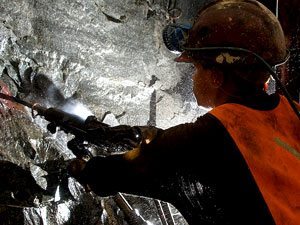
[miningmx.com] – SOUTH African gold miners have proposed a five-year wage deal to unions in which increases to basic pay for entry-level workers are set between 7.8% to 13% a year, and include a profit share element.
In return, the industry wants agreement from unions that they will support efforts to lift the productivity of mines through “new forms of work organisation”.
The offer was the keynote as a second, three-day negotiation process began involving the Chamber of Mines (CoM) which representing AngloGold Ashanti, Sibanye Gold and Harmony Gold, as well as Village Main Reef, and Pan African Resources’ Evander Gold Mines.
Unions represented at the wage talks are the National Union of Mineworkers (NUM), Solidarity, UASA and the Association of Mineworkers & Construction Union (AMCU) which talks for about 30% of the industry’s 94,000 workers.
A three-day negotiation process last week saw unions set down more than 80 demands including that entry-level miners receive an 80% wage boost. The offer by the CoM today guarantees job retention and wage increases provided profitability is in place.
In terms of the profit or gain share, an improvement in operating profit will earn workers between 3% and 5% of profits earned on average over the proceeding six months which will be shared equally among employees.
The rates of profit sharing are slightly different with Sibanye Gold and Harmony willing to part with 5% of profit while at AngloGold Ashanti some 3.5% of profit will be shared.
However, AngloGold Ashanti has offered annual wage increases of 13% for entry-level workers whilst Sibanye Gold and Harmony Gold have offered 11.1% and 7.8%.
Miners, artisans and officials will receive a 4.5% wage increase annually at Harmony, and increases of 5% and 6% for Sibanye Gold and AngloGold Ashanti respectively.
The profit share will not be capped and would be in addition to any production or safety allowances or bonuses earned, the CoM said.
In hard monetary terms, the increases in the first year for entry-level workers amount to R450 for Harmony Gold employees, and R625 and R750 for Sibanye Gold and AngloGold Ashanti respectively.
In addition, the CoM sought to eventually replace the living out allowance to employees with the efforts of a special purpose vehicle which would aim to “… benefit from economies of scale to reduce the cost of housing and speed up delivery”, it said.
A target on worker indebtedness of no more than a quarter of net pay had also been earmarked by the CoM on behalf of the companies.
The offer was in terms of the CoM’s ‘compact’ to unions which set down an economic model showing how each of the company’s financial fortunes changed based on assumptions ranging from gold price declines to administered costs (Eskom) through to the impact of productivity improvements.
Crucially, the CoM said that any shaft regularly incurring an operating margin of 6% or lower would be earmarked for restructuring and possible closure. This compares to average margins in the industry calculated at 10%, by Goldman Sachs in a recent report on the wage talks.
In return, the companies had asked unions and employees to “… commit their support [to] existing and new initiatives to enhance operational efficiency, including the introduction of new forms of work organisation, greater diversity of skill acquisition and flexibility, team work and any other mutually agreed measures that will enhance output, efficiencies and the quality of life of employees”.
“The industry understands that employees are also facing many challenges, which have given rise to their wage demands, but also recognise the implications of job losses on employees and communities,” the CoM said.
“While the industry’s production has halved to around 168 tons in the past decade, employment levels have declined by around 30% to 119,000 jobs, adding to the already-high levels of unemployment in South Africa,” it said.








